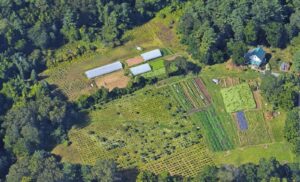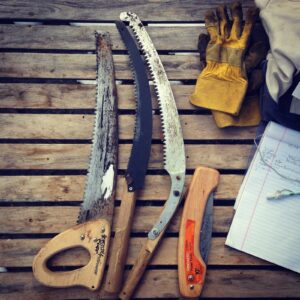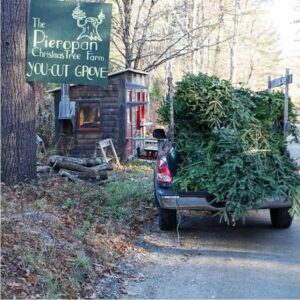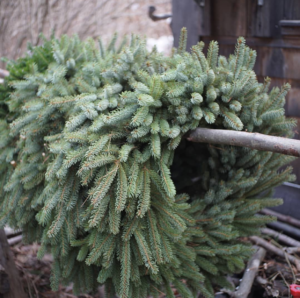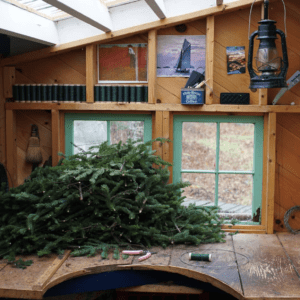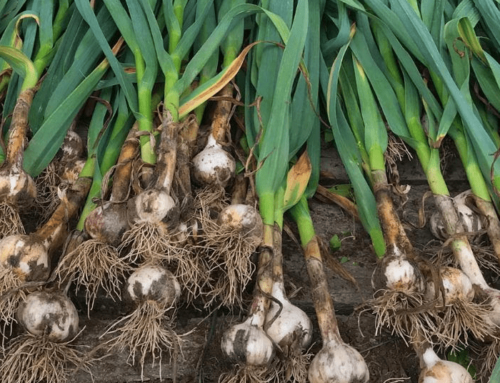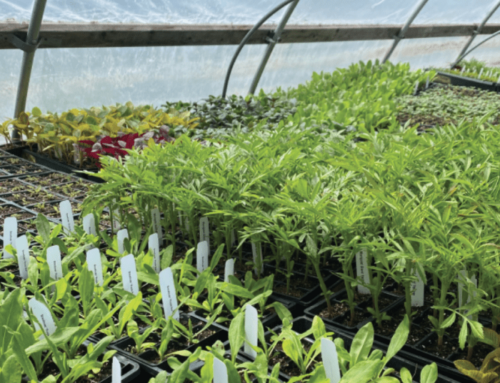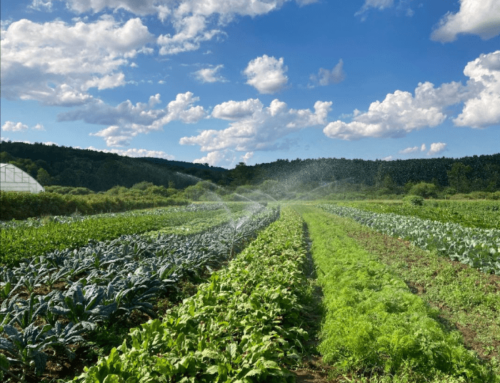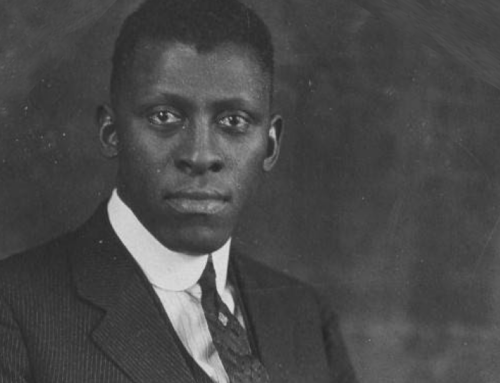By Caro Roszell, NOFA/Mass Education Director
For those of us who aspire to make sustainable and regenerative consumption decisions, the holidays are an Olympic-level event! With so many gifts, decorations, and food items to buy in so little time, it can seem overwhelming to think carefully about each purchase.
If your family buys a Christmas tree, you might want to give it just as much thought as your other holiday purchases. According to Beyond Pesticides, “The pesticides that the U.S. Environmental Protection Agency (EPA) registers for use on conventionally grown Christmas trees are linked to numerous adverse health effects, including cancer, hormonal disruption, neurotoxicity, organ damage, reproductive/birth defects, asthma, and more.” And less than 1% of the Christmas tree market in the United States is organic, so it can be very hard to find a tree you can be sure was grown without harmful sprays. Also, when you consider that the leading Christmas tree producing states are Oregon, North Carolina, Washington and Michigan, you might start to question the impact of your tree’s ecological and carbon footprint.
But don’t worry! It’s not difficult to find a local producer that uses sustainable agroforestry techniques to grow Christmas trees without the use of pesticides. Here are two interviews with ecologically responsible Christmas tree farmers from the NOFA/Mass network.
Certified Organic Christmas Trees with Richard Robinson of Hopestill Farm in Sherborn, MA (& NOFA/Mass Board Member!)
Q: Can you tell me a little bit about your farm?
It’s very old family farmland dating back to the 1650’s. My grandfather grew Christmas trees, though not in a highly commercial way; mainly for neighbors—it was just a small part of the business.
I didn’t start farming until 1978, and at the time I did plant some Christmas trees, but they did terribly. My grandfather was dead by then and there wasn’t anyone in the family at the time who could give me instruction on the practice.
The Christmas trees didn’t really become a real going concern on the farm until 2004, when we started to get serious about farming. At that time, we planted the first serious tree crop– and instead of planting at the field edges, we planted them in the hayfield. The hayfield wasn’t making us much money, and it was at the heart of the farm. They have done fantastically in that field.
Q: And the trees are certified organic?
Well, the way it works is that the fields are certified organic, so what grows there is certified organic, so all of our produce from our vegetables to our trees are certified.
Q: What are your growing practices?
We plant only Spruce, because we do not have fencing. The deer will demolish Firs and Hemlock, and we have huge numbers of deer. I did try planting some Balsam Fir once but when I came back to the field I could barely find them– they had been nibbled to the ground.
We plant Spruce on a six foot grid, and we don’t leave truck paths through the woods like many other growers, so ours are at a 1200-1400 trees per acre density.
We plant four-year-old bareroot trees from a nursery in Michigan, where they’re grown in sandy soil with, I imagine, nutrients added. We drive a wedge into the soil, which makes a slit, and plant the bareroot tree into that slit. In the first year it doesn’t grow at all. The following year it puts on a few inches and the third year it starts putting on a foot per year. At six feet in height the tree starts growing faster.
The timeline is four years to grow a seedling of size, and then another six to eight years until the tree is ready to harvest. Some trees don’t shape up properly and they stay in the ground longer, but eventually someone comes along who wants a giant bargain and will buy a large tree.
Q: What do you do for fertility and pest/disease management?
Well there are two different replies to that question. For fertility, nothing. As far as I can tell, these trees do not want the same things that vegetables want.
What they really want—and this is about spruce in particular—is lots and lots and lots of water. I actually had a batch of trees that were planted near a ditch in the field, which kept that part of the field very wet – those look particularly beautiful.
As far as pests go, there is a gall aphid that seems to affect mature trees, but it’s really not problematic. We have had enormous gypsy moth problems for the last couple years. We used Bt (bacillus thuringiensis) and it worked pretty well.
However, this past year was a crash year for the gypsy moth—the previous three years were very dry, and a major check for the gypsy month is a fungus that keeps the population down. So, the population was growing in the dry years. But we finally had a very wet fall followed by a wet spring and that did them in, though not before we lost a huge number of oak trees.
Q: Do you cut the trees or do the customers cut them? How do you market them?
People cut their own here. All of our trees are by the tree, rather than by the foot, and people choose and cut their own. While we do like them cut to the ground, customers can take any portion of the tree to customize their length.
We love doing it this way– for some people it’s one of the rare times in the year when they get to have contact with something agricultural or silvicultural. We supply saws, or you can supply your own saw. It is really easy, just a 4-5” stump and it takes maybe five minutes including getting into position. People can sometimes be shy at first about it, but they’re always amazed by how quickly it goes and afterwards they’re so excited—it’s a real experience for them.
Then we help people (if they want the help) to tie the tree up on their cars—we supply the twine and it takes me about 3 minutes.
Q: How has the Christmas tree industry changed over your time growing them?
I really don’t know—I’m such a small producer—we sell between 150 and 200 per year which is a drop in the bucket. So, I’m not in tune with the larger market.
It can be a hard business to get into for those farmers who don’t own their land—you need to lock in 8-10 years to take a risk on Christmas trees. The business about being a certified organic Christmas tree farm is really not that much of a draw for many people. I wish it were, but it’s very rare to find someone who came to us because of our certification. People come for two main reasons– the experience, and because a fresh cut tree will stay fresh longer than a tree that has been cut farther in advance and not kept in water. Our trees get cut and placed in water within an hour or so—and they drink gallons in the first few days because they’re so fresh. Some customers report that they have kept their trees into the spring.
Our trees are a flat $65, but you get $5 off if you are a NOFA/Mass member or if you join when you buy your tree!
Q: What can people do to make sure they have a sustainable Christmas tree even if they can’t get one from a local farm like yours?
They could plant their own! You can get evergreen seedlings at nurseries – though not from the same nurseries that I do since they deal in hundreds—or you can always buy a potted tree that you can plant afterwards. Just be sure to look up or get advice or know how to plant it.
But really anyone around Massachusetts who is planting Christmas trees is doing so on relatively small lots and generally as a part of an integrated farm enterprise, so buying local is a good bet—so make sure you buy local!
Hopestill Farm’s Farmstand is open and stocked with fresh organic produce every day during daylight hours during the growing season, usually from the beginning of May to the middle of November.
Coppiced Christmas Tree Agroforestry with Emmet Van Driesche of The Pieropan Christmas Tree Farm, Shelburne Falls, MA (& author of the book Carving Out a Living on the Land)
Q: Can you tell me a about the history of your farm?
Sure, it was started in 1953 by Al Pieropan. He was influenced by Linwood Lesure, who was over at the other end of town—Lesure was a big deal in the Christmas tree world, and he had figured out that some of the stumps from trees he was cutting from his forest—the ones that had a few branches remaining on the stump– were growing back.
Al was an agricultural teacher in Ashfield and was trying to figure out how to use his 25 acres of scrubby pastureland. He didn’t want to grow tobacco like many of the other area farmers, so he bought some seedling trees. But, actually, most of the trees he planted he just pulled from the side of the road, loaded them into gunny sacks and took them back to his farm. Over about 10 years he planted about 10 acres this way, mostly from trees pulled from the side of the road on his way home from work.
Really, Christmas trees as a consumer item only began in 1900. People were cutting them from young forest, and no one was putting them into hayfield because that would be a waste of good hayfield. But Lesure was the president of the Christmas Tree Association for a few years and so his idea really spread. This practice of stump-grown trees really took root in the west coast where the large stumps withstand the dry conditions well. But around here it hasn’t been the practice.
It’s too bad, because it’s actually a fairly simple practice—if you maintain the stump well and cut back the skirt of greens regularly and leave one lead branch, then the stumps keep going strong. Coppicing is known to extend the life of the species.
So many Christmas tree farms get abandoned because of the long turnaround time from planting to harvest, but his farm has stuck around for 60 years, and it goes back to Lesure, the first person I’m aware of who figured out how to grow stump-grown trees.
Q: What are your growing practices?
When you cut a tree, that removal of the top layer causes the stump to bud out all over, both around the base of the stump and on any branches you leave, which will try to become trees—so my job is to remove all of that skirt to favor one strong branch that becomes a tree.
We then use most of the skirt of greens for wreaths. Using this method, I can harvest a tree every 3-4 years from the same stumps.
So far, I haven’t done any fertility or irrigation or pest management. I do have some areas where needles that were bright green in the spring seem to turn yellow over the season—and I’m not clear what’s going on. Some people think it’s lack of nitrogen from leaching, others say it’s a lack of iron, some folks suggest it’s about the soil moisture—I think it might be micronutrients. So, next year I’m going to do a comprehensive experiment with fish meal, azomite, and a few different amendments and see if there is a difference in the yellowing based on the amendment addition.
As far as pests and disease—there is a certain type of scale that seems to only take hold on overgrown trees, which I’ve been cutting back and selling the branches. But from what I can tell it’s not an epidemic, which I attribute to the fact that it’s a managed ecosystem. It’s a managed forest with about 90% Balsam Fir, but there are enough other plants coming up that the ecosystem diversity keeps pests and diseases in check.
When I’m cutting greens for wreath-making, I’m also cutting saplings down for poles, cutting the understory back, and some species I select and save like certain azaleas and rhododendrons. Then that area will be good for about three years until I come back again.
Can you tell me a little about the other enterprises you’ve stacked onto your Christmas tree enterprise?
There are three main enterprises that I do in addition to the trees: wreaths, making roping or garland, and boughs. There is certainly a demand for roping because it’s hard to find, but the price you can command for it is low compared to other uses of my time, and it’s really hard on my body.
I once did hundreds and hundreds of feet for historic Deerfield to decorate their town center, and it was just so hard on my body. Wreaths are a much better enterprise for me, especially once I got good at it. It’s a real skill to make a wreath look slightly random but still nice—and the physical stamina to do it all day took time. I expect someone tying a wreath for the first time to take about half an hour, but at this point it takes me about 10 minutes tying plus about 5 mins to cut the greens per wreath. I can do about 44 wreaths per day, and I tie about 500 wreaths a year.
The third thing is the balsam boughs. I need to trim the stumps anyway so as I work a section of the grove, trimming, I tie them into 50# bales and walk them to my truck—I think selling the greens works well because it boils down to having 3-4 customers who want a lot of bales.
Do you cut the trees or do the customers cut them? How do you market the trees and greens?
We sell 350-500 trees per year, about 500 wreaths per year, plus boughs.
People can come and cut their own tree. In addition to cut your own we have also had a number of wholesale buyers over the years. This year our only wholesale account is through Hadley Garden Center, where we’ve sold for a long time. Also for this year we’re doing pop up tree sales at River Valley Market and Atlas Farm Store on the weekends of December 7-8 and 14-15, so people can call those retailers to find out when they can come by and buy directly from us.
Check out Emmet’s book Carving Out a Living on the Land over at Chelsea Green’s website.
Know a Massachusetts farm that grows and sells organic Christmas trees and greenery? Let us know so that we can add them to The Organic Food Guide, our online searchable database of sustainable and organic food and farm products available in Massachusetts.

